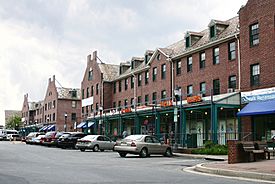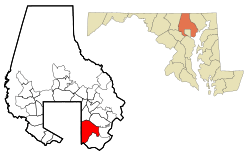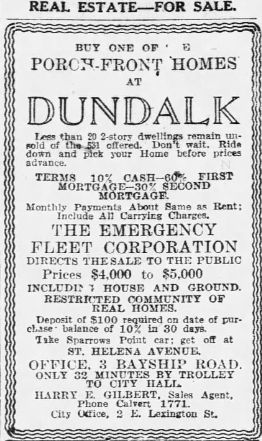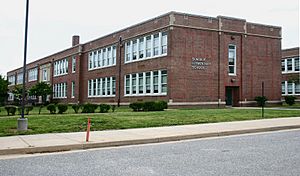Dundalk, Maryland facts for kids
Quick facts for kids
Dundalk
|
||
|---|---|---|

The Dundalk Shopping Center, in May 2006.
|
||
|
||

Location in the U.S. state of Maryland
|
||
| Country | ||
| State | ||
| County | ||
| Founded | 1856 | |
| Area | ||
| • Total | 17.41 sq mi (45.10 km2) | |
| • Land | 13.09 sq mi (33.90 km2) | |
| • Water | 4.33 sq mi (11.20 km2) | |
| Elevation | 16 ft (5 m) | |
| Population
(2020)
|
||
| • Total | 67,796 | |
| • Density | 5,180.01/sq mi (2,000.08/km2) | |
| Time zone | UTC-5 (EST) | |
| • Summer (DST) | UTC-4 (EDT) | |
| ZIP code |
21222
|
|
| Area code(s) | 410, 443, 667 | |
| FIPS code | 24-23975 | |
| GNIS feature ID | 0590117 | |
Dundalk is a community in Baltimore County, Maryland, in the United States. It's not a city with its own government, but it's a large area where many people live. In 2020, about 67,796 people called Dundalk home. For a while in the 1960s and 1970s, it was the biggest community of its kind in Maryland!
Dundalk got its name from a town in Ireland called Dundalk. It's known as one of the first "inner-ring suburbs" of Baltimore. This means it was one of the first towns built just outside a big city to help people live close to their jobs.
Contents
The History of Dundalk
Early Days and Founding
The land where Dundalk now stands was first explored by John Smith in 1608. Before that, the Susquehannock tribes lived there.
In 1856, a man named Henry McShane, who came from Ireland, started a bell-making factory called the McShane Bell Foundry. It was located near the Patapsco River in what was then the edge of Baltimore. When a railroad needed a name for a stop near his factory, McShane chose "Dundalk," after his hometown in Ireland.
Building a Community
In 1916, a big steel company called Bethlehem Steel bought a lot of land near McShane's factory. They wanted to build homes for their workers who built ships. The Dundalk Company was created to plan a new town. They wanted it to be a nice place with homes, stores, schools, and parks.
By 1917, Dundalk officially began. It had 62 houses, two stores, a post office, and a telephone system. The streets were laid out in a simple pattern and had names like "Shipway" and "Admiral." Many workers, especially white workers, moved to Dundalk during World War I because there was a lot of demand for steel. Some African American workers moved to a nearby community called Turner Station, which also grew a lot during World War II.
Many people from the Appalachian Mountains also moved to Dundalk. They came looking for jobs and a better life, especially before and after World War II.
Today, the historic part of Dundalk is recognized as the Dundalk Historic District. It was added to the National Register of Historic Places in 1983.
Dundalk's Location and Landscape
Dundalk covers about 17.4 square miles (45 square kilometers). A good portion of this area, about 4.3 square miles (11.2 square kilometers), is water.
Most of Dundalk is flat and very close to sea level. There are a few small hills closer to the city of Baltimore. Dundalk is part of the Atlantic Coastal Plain, which is a flat, low-lying area along the coast. The land ranges from sea level near the Chesapeake Bay to about 40 feet (12 meters) above sea level in some northern parts.
A stream called Bread and Cheese Creek flows through Dundalk. It's about 8.5 miles (13.7 kilometers) long and eventually flows into the Back River, which then goes into the Chesapeake Bay.
People of Dundalk
Dundalk has been home to many people over the years. In 2020, the population was 67,796. The community is diverse, with people from many different backgrounds living there.
Getting Around Dundalk
Roads
A major highway, Interstate 695, also known as the Baltimore Beltway, goes through Dundalk. This highway used to cross the Patapsco River on the Francis Scott Key Bridge, which was a very important bridge for the area.
Other important roads in Dundalk include:
- Dundalk Avenue
- Eastern Avenue
- Holabird Avenue
- Merritt Boulevard
- North Point Boulevard
- Sollers Point Road
- Wise Avenue
Public Transportation
In the past, people in Dundalk used streetcars to travel to Sparrows Point and Baltimore City. These streetcars, sometimes called "Red Rockets," were very busy, especially during World War II. Later, bus services took over.
Today, the Maryland Transit Administration (MTA) provides public transportation. You can find many bus lines that serve the Dundalk area, helping people get where they need to go.
Learning in Dundalk
Dundalk has good options for education. There is a campus of the Community College of Baltimore County (CCBC-Dundalk), where students can take college classes.
For younger students, the Baltimore County Public Schools system serves the area. The main high schools are Dundalk High School, Patapsco High School, and Sparrows Point High School. Dundalk is also home to Sollers Point Technical High School, which is special because it offers technical training and has a high-quality certification.
Keeping Dundalk Safe
The Baltimore County Police Department has a station in Dundalk (Precinct 12) that helps keep the community safe.
Several fire stations also serve the Dundalk area, ready to respond to emergencies:
- Dundalk Station 6
- Eastview Station 15
- Edgemere Station 9
- Sparrows Point Station 57
- North Point-Edgemere Vol. Station 26
- Wise Avenue Vol. Station 27
Community Support
Dundalk has organizations that help the community:
- Dundalk Renaissance Corporation: This group is a nonprofit that works to improve the community.
- Living With Grace: This nonprofit helps older women who have limited income get the medical supplies they need.
Famous People from Dundalk
Many interesting people have come from Dundalk or lived there:
- Nestor Aparicio: A sports writer and radio host.
- Joshua Barney: A brave United States Navy leader during the Revolutionary War and the War of 1812.
- Kevin Clash: The talented person who performs Elmo and other Muppet characters.
- Robert Curbeam: A NASA astronaut.
- Ron Franklin: A jockey who won famous horse races like the Kentucky Derby.
- Rudy Gay: An NBA basketball player.
- Calvin Hill: A former NFL football player and father of NBA star Grant Hill.
- Henrietta Lacks: A very important person in medical history whose cells have helped scientists learn a lot.
- Bucky Lasek: A professional skateboarder and race car driver.
- Gina Schock: The drummer for the famous band The Go-Go's.
- Scott Seiss: A comedian and actor known for his TikTok videos.
- Danny Wiseman: A professional bowler with many titles.
- Bernie Wrightson: A famous illustrator known for his horror art and comic books.
See also
 In Spanish: Dundalk (Maryland) para niños
In Spanish: Dundalk (Maryland) para niños




